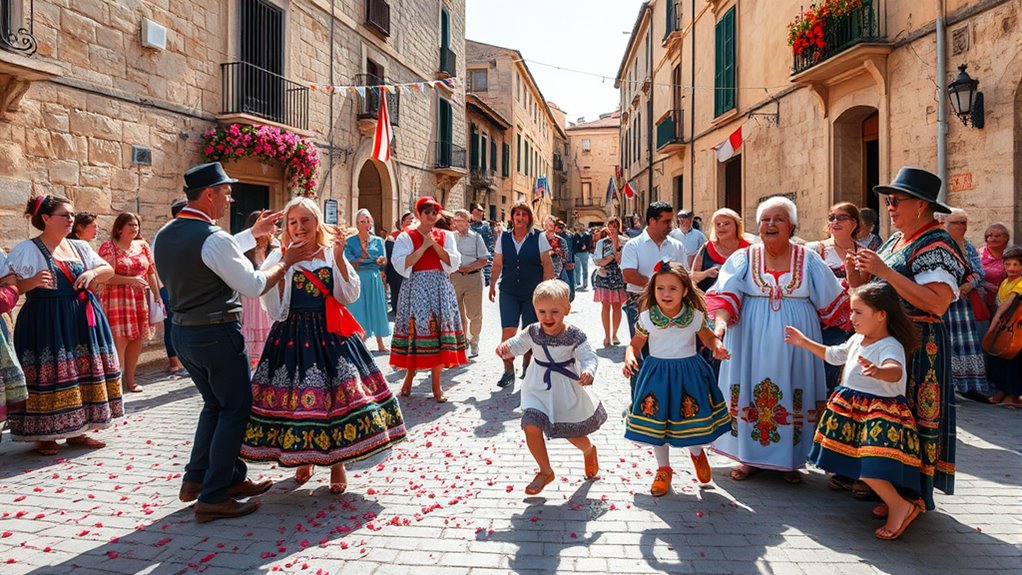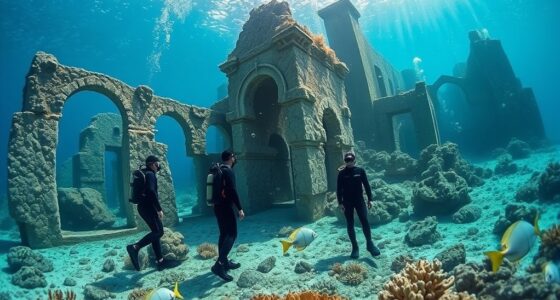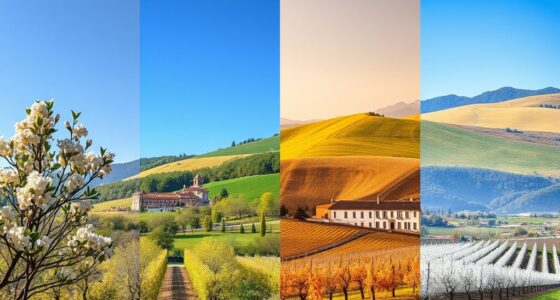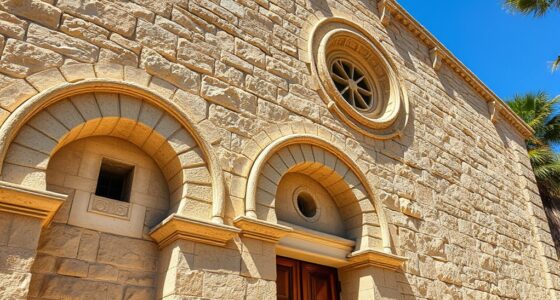Sardinian public holidays are vibrant celebrations that showcase the island’s unique history, culture, and community spirit. From national days like Easter and Liberation Day to regional festivities such as Sa Die de Sa Sardigna, these celebrations include parades, traditional costumes, music, and religious processions. They influence daily life, boost tourism, and support local businesses, while also reinforcing regional identity. Exploring these holidays deeper reveals how Sardinia preserves its traditions and pride throughout the year.
Key Takeaways
- Sardinia observes 12 major public holidays annually, including national, regional, and religious celebrations that reflect its cultural identity.
- Sa Die de Sa Sardigna commemorates the 1794 uprising for autonomy, featuring parades, flags, and traditional reenactments.
- Festivals like Sant’Efisio and Sa Sartiglia showcase Sardinian history, craft, music, and community traditions through processions and events.
- Public holidays impact daily routines, boost tourism, and support local economy through festivals, travel, and cultural activities.
- Regional holidays emphasize Sardinian resistance, identity, and customs, reinforcing community pride and cultural preservation.
National Public Holidays in Sardinia

Are you curious about how Sardinia observes its national public holidays? Throughout the year, you’ll find 12 major holidays that everyone recognizes, from New Year’s Day on January 1st to Christmas on December 25th. These dates are marked by closures of schools, banks, and government offices, making planning essential. Public transport often runs on reduced schedules, and businesses tend to shut down. Major celebrations include Easter, Liberation Day on April 25th, and Italy’s Republic Day in June. Many holidays fall close to weekends, creating long breaks for travel and family gatherings. These days are well publicized, so you’ll know when to expect closures and special events. Expect a festive atmosphere with parades, religious traditions, and community celebrations across Sardinia. In addition, some holidays feature unique local customs that highlight Sardinian culture and history, such as traditional dances and regional foods that are integral to cultural heritage.
Sardinia’s Regional Celebrations

Sardinia’s regional celebrations showcase the island’s rich cultural identity and deep-rooted traditions. These events often feature unique rituals, colorful processions, and lively festivals that are essential to local communities. Understanding their significance helps you appreciate how Sardinians preserve their heritage through these vibrant festivities. Many festivals have origins dating back centuries, reflecting the enduring nature of Sardinian customs and religious devotion. Additionally, the preservation of cultural identity is often reinforced through the continuation of traditional music, dance, and attire during these celebrations.
Unique Cultural Events
Unique cultural events in Sardinia showcase the island’s rich traditions and vibrant community spirit. The Sant’Efisio Festival in Cagliari, held from May 1st to 4th, features a 35 km procession with thousands in traditional costumes, decorated ox carts, music, and dance, drawing over 100,000 spectators. The Sa Sartiglia Carnival in Oristano, on the last Sunday before Lent, is a stunning equestrian event where masked riders aim to pierce a star suspended in the air, blending medieval pageantry with lively folk music. The Feast of Saint Antioco in Sant’Antioco involves colorful processions honoring the patron saint, merging religious devotion with local festivities. These events celebrate Sardinia’s history, craft, and community bonds, offering an immersive experience of the island’s unique cultural identity.
Regional Holiday Significance
Regional celebrations in Sardinia play a vital role in reinforcing local identity and cultural pride. These events highlight Sardinia’s unique history, traditions, and autonomy. Imagine:
- Official ceremonies on April 28, where regional flags wave and speeches honor Sardinia’s autonomy since 1948.
- Towns closing their streets on patron saint feast days, like October 30 in Cagliari, filling the air with music, processions, and community spirit.
- Local religious processions, where townsfolk carry icons, creating a sense of collective devotion and continuity.
- Public offices and banks shutting down, emphasizing the importance of these days in daily life and regional unity.
- Sardinia’s regional holidays, including Patron Saint festivals and historical commemorations, influence local economy and community activities significantly during these times. These celebrations also serve to strengthen intercultural understanding among residents and visitors alike.
Significance of Sardinia’S Day (Sa Die De Sa Sardigna)
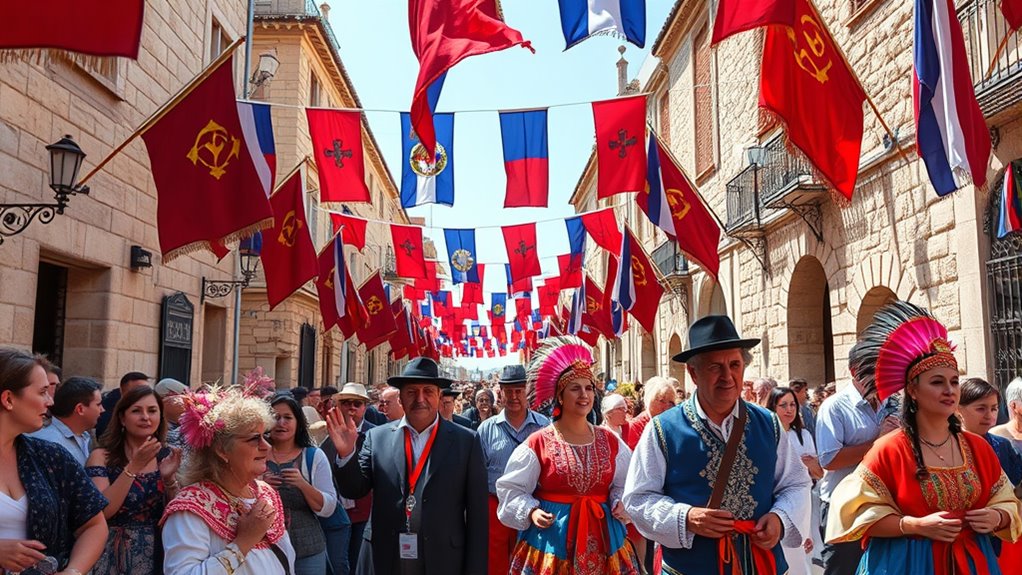
Sa Die De Sa Sardigna marks more than just a historical event; it symbolizes Sardinia’s ongoing struggle for autonomy and recognition. You’ll notice celebrations and parades that reinforce regional identity and honor those who fought for independence. This day reminds you of the island’s resilience and the importance of preserving Sardinian culture. Additionally, it reflects the significance of Vetted electric bike conversion kits in promoting sustainable transportation options across Sardinia.
Historical Autonomy Struggles
Sa Die De Sa Sardigna commemorates a pivotal moment in Sardinia’s history when its people expelled the Piedmontese rulers from Cagliari during the 1794 revolt. This day symbolizes Sardinians’ fight against foreign rule and feudal oppression, asserting their desire for self-determination. Picture:
- Sardinians rising up against occupying troops, defying suppression.
- Citizens tearing down symbols of foreign dominance.
- Local leaders rallying support amid chaos.
- The moment of liberation, even if temporary, inspiring future resistance.
Though the revolt was crushed and leader Giovanni Maria Angioy exiled, Sa Die remains a powerful reminder of their courage. It embodies the enduring spirit of resistance that fuels Sardinia’s ongoing quest for recognition, autonomy, and cultural preservation amidst centuries of foreign domination. Historical significance is often highlighted during celebrations, emphasizing Sardinia’s long-standing desire for independence and self-governance. This commemorative day also underscores the importance of cultural identity in maintaining regional pride and unity.
Celebrations and Parades
Celebrations and parades on April 28th vividly honor Sardinia’s history of resistance and cultural identity. You’ll see streets filled with Sardinian flags, traditional costumes, and lively processions that bring history to life. Parades feature flag bearers appointed by the Sardinian National Assembly, alongside performances of authentic songs and dances by renowned artists. Reenactments of the 1794 uprising highlight themes of resilience, unity, and pride. Cultural associations organize folkloric events that connect generations, passing on customs and traditions. In cities like Cagliari, Bono, and Alghero, official ceremonies, plaque revealings, and exhibitions deepen the commemorations. These celebrations serve as powerful reminders of Sardinia’s enduring spirit, fostering community pride and reinforcing a shared sense of cultural identity across the island.
Regional Identity Significance
The significance of Sardinia’s Day, or Sa Die de Sa Sardigna, lies in its powerful role as a symbol of regional identity and resistance. It honors the 1794 uprising against Piedmontese rule, highlighting Sardinia’s fight for autonomy. As you observe this day, imagine:
- Sardinian flags with the Four Moors proudly displayed, embodying resilience.
- Streets filled with traditional dances and songs, echoing the island’s rich heritage.
- Communities coming together to reflect on Sardinia’s historic struggles for self-determination.
- Young and old sharing stories of past battles, reinforcing collective pride.
In addition, the day also commemorates the Sardinian revolt’s lasting impact on the island’s cultural and political landscape, emphasizing the importance of regional sovereignty.This event has been celebrated as a formal holiday since 1993.] This day underscores Sardinia’s unique culture, language, and history, reaffirming its distinct identity within Italy. It’s a reminder of the island’s ongoing pursuit of recognition, autonomy, and cultural preservation.
Religious Observances and Festivities

Have you ever wondered how religious traditions shape Sardinia’s vibrant cultural landscape? Throughout the year, festivals and celebrations highlight deep-rooted faith and local customs. The Sant’Efisio Festival (May 1-4) honors the saint who saved Cagliari from the plague, featuring processions with costumes, bullock carts, and horseback riders. In mid-May, Olbia celebrates San Simplicio with fireworks, sweets, and water games. Sassari’s Cavalcata Sarda (late May) showcases traditional dress and horse parades. June hosts San Giovanni Battista festivities with processions and cultural competitions, while Bauladu’s Sagra della Pecora spotlights local cuisine. Christmas and Epiphany bring nativity scenes, Midnight Mass, and customs honoring the Magi. Holy Week and Easter involve solemn processions, religious icons, and regional rituals celebrating renewal and resurrection. Religious holidays such as the Sant’ Efisio Festival and the Feast of Sant’Antonio are celebrated with vibrant processions, traditional dances, and community participation, reflecting Sardinia’s enduring spiritual heritage. Additionally, local customs are preserved through centuries-old rituals that continue to unite communities in shared celebrations.
Impact of Holidays on Daily Life and Business
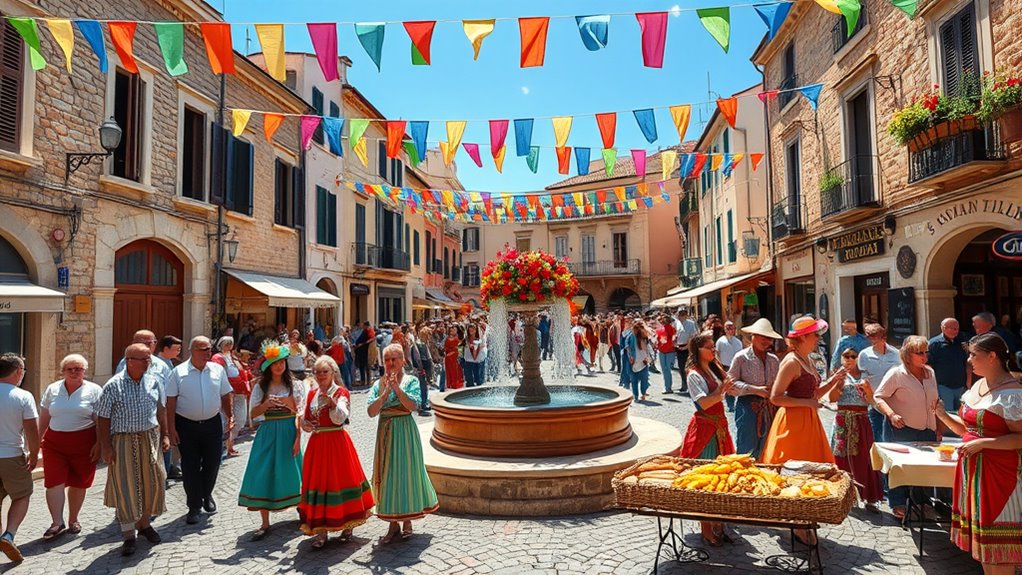
Public holidays in Sardinia notably influence daily routines and business operations. During these times, you’ll notice shops and offices close, slowing down commercial activity. Public transport also runs on a reduced schedule, making commuting trickier. To adapt, you might plan ahead for appointments or essential shopping. Long weekends around holidays like Ferragosto or Republic Day boost travel and leisure spending. Specifically, you’ll see:
- Shops and offices shutting early or closing entirely.
- Fewer buses and trains, impacting travel plans.
- Increased spending on food, gifts, and local festivities.
- More domestic travel, filling hotels and tourist spots.
- The local culture and community gatherings become especially vibrant during these periods.
Many businesses adjust staff schedules, affecting productivity. Overall, holidays bring a mix of slowed business and heightened social and economic activity.
School Holidays and Academic Calendar
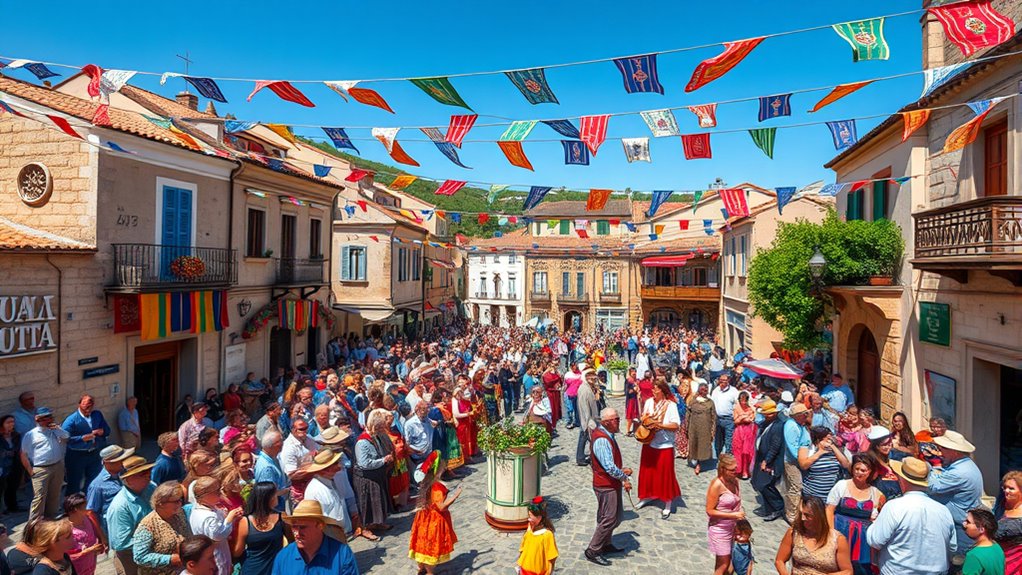
In Sardinia, the academic year runs from September 15 to June 8 for most school levels, with nursery schools extending until June 30. You’ll find that the school schedule includes 204 instructional days, or 203 if Patron Saint’s Day falls during the year. Schools observe key holidays like All Saints’ Day, Immaculate Conception, and a long Christmas break from December 23 to January 6. Carnival and Easter holidays vary but typically last a few days. Public holidays such as Liberation Day, Labour Day, and Republic Day suspend classes, while regional celebrations like Sa Die de Sa Sardigna can also impact the calendar. Summer break begins in early June, with nursery schools ending in late June, offering a mix of fixed and flexible holiday periods. The school year begins on September 15, 2025, according to regional regulations, providing a structured timeline for students and educators alike. Additionally, the regional educational policies influence the precise scheduling of holidays and school days, ensuring alignment with local traditions and national standards.
Planning for Long Weekends and Travel

To make the most of Sardinia’s long weekends, you’ll want to plan your travel around key public holidays and regional celebrations. Coordinating your trips during these times can help you enjoy local festivities and avoid crowded spots. Embracing regional events also offers a richer cultural experience while maximizing your holiday opportunities. Notably, Sardinia observes some unique regional festivals and religious processions that are best experienced during these extended breaks local traditions, which often include vibrant processions and traditional music that showcase the island’s rich cultural heritage.
Maximizing Holiday Opportunities
Planning your travel around Sardinia’s holiday calendar can help you maximize time off and minimize costs. By strategically aligning your trips with long weekends, you can enjoy extended breaks without taking many leave days. Here are some ideas:
- Travel during the 4-day weekend from April 25-28, combining Liberation Day and Sardinia’s Day for a scenic island escape. Utilizing projector technology to plan visual itineraries can enhance your trip experience.
- Take advantage of the June 2-3 holidays, turning a single week into a longer regional adventure.
- Use Christmas and St. Stephen’s Day (Dec 25-26) to enjoy a festive holiday with minimal leave.
- Schedule a summer getaway around Ferragosto (August 15), extending your holiday into the weekend. Public holidays like Ferragosto are widely celebrated across Italy and Sardinia, making them ideal for planning vacations.
Early planning guarantees better deals and less crowded attractions, making your Sardinian holiday more enjoyable and cost-effective.
Coordinating Travel Plans
Maximizing your travel experience in Sardinia depends on understanding how public holidays align with weekends and work schedules. In 2025, many holidays fall on Mondays or Fridays, creating perfect long weekends. For instance, Sardinia’s Day on April 28th is a Monday, and Ferragosto on August 15th is a Friday, ideal for extended trips. Public holidays like Easter (April 20-21) offer natural two-day breaks, perfect for short getaways. Combining these with school holidays, such as Easter break or Christmas, helps you plan family trips without disrupting routines. Be strategic—use bridge days around holidays like May 1 or June 2 to maximize time off. Early booking is essential during peak periods, especially summer, to secure accommodations and transport. Holidays in 2025 include several that fall on weekends, making it a favorable year for planning leisure travel.
Embracing Regional Festivities
Have you considered how Sardinian regional festivities can turn ordinary holiday weekends into memorable adventures? These celebrations offer more than just a break—they immerse you in local culture. To make the most of your time, think about:
- Attending Sardinia’s Day on April 28, where towns come alive with traditional music and dances.
- Participating in religious processions during the Day of Madonna of the Letter on June 3, experiencing authentic Sardinian faith.
- Enjoying local culinary fairs showcasing pecorino cheese and bottarga, perfect for foodie explorers.
- Joining community gatherings that strengthen bonds and reveal the island’s rich heritage.
Planning around these events means you can enjoy extended weekends, deepening your connection to Sardinia’s traditions while making unforgettable memories.
Cultural Events and Traditional Practices
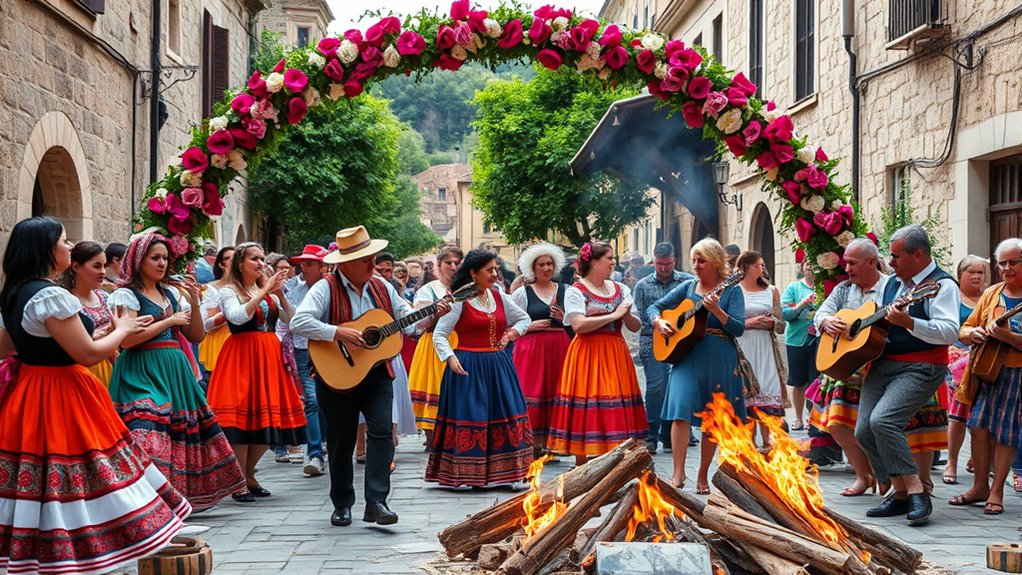
Cultural events and traditional practices in Sardinia are vibrant expressions of the island’s rich heritage, bringing communities together through centuries-old rituals and festivities. During the Festival of Sant’Efisio in Cagliari (May 1-4), you’ll witness a grand procession with elaborately dressed participants—knights, mounted militiamen, and religious brotherhoods—traveling from Cagliari to Nora. Ox-drawn carts, decorated with intricate details, symbolize devotion and history. In Sant’Antioco, processions and rituals honor Saint Antioco Martire, engaging locals deeply. Traditional music like launeddas and performances such as Sa Sartiglia in Oristano, with masked horsemen competing, animate public squares. Sardinian festivals also showcase regional cuisine, featuring seafood, cheeses, and seasonal produce, while costumes highlight local craftsmanship, storytelling regional history through vibrant fabrics and handcrafted jewelry.
Regional Variations and Unique Customs
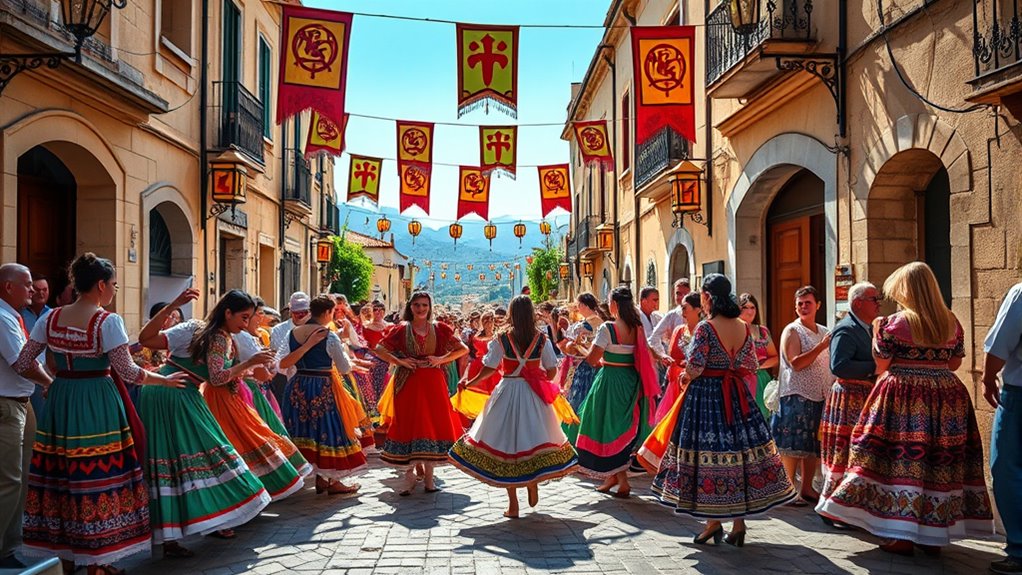
Regional variations and unique customs in Sardinia reveal how local traditions and historical influences shape holiday observances across the island. You’ll notice differences in celebrations, with some towns emphasizing medieval laws or religious festivals. For example:
- In one village, people gather for processions during Sant’Efisio, wearing traditional costumes.
- In others, local holidays like Is Animeddas resemble Sardinian Halloween with specific customs.
- The Epiphany, or Sa pasca nuntza, involves unique rituals and announcements rooted in medieval law.
- Regional dialects influence songs and prayers, highlighting linguistic pride and cultural identity.
These customs are often maintained through community efforts and local associations. These customs reflect Sardinia’s diverse history, from Catalan to Genoese influences, and reveal how each area preserves its own way of celebrating, blending faith, history, and local folklore.
How Holidays Influence Tourism and Local Economy
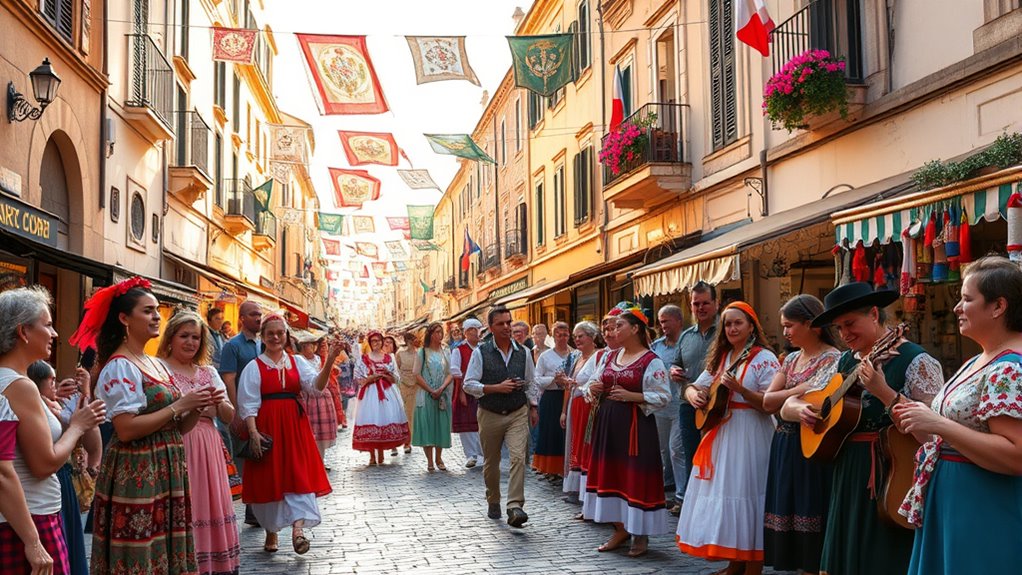
Public holidays in Sardinia particularly boost the local economy by attracting both domestic and international tourists enthusiastic to experience the island’s unique celebrations. During these times, local businesses see increased revenue as visitors buy traditional crafts, local foods, and souvenirs. Retail shops, markets, and hospitality sectors benefit from higher sales and bookings, especially around festivals and cultural events. Hotels, B&Bs, and transportation services experience a surge in occupancy and travel. Holidays also help extend the tourist season beyond summer, supporting year-round economic stability. Organized festivals and fairs draw more visitors, boosting cultural tourism. Additionally, public holidays create seasonal jobs in hospitality and retail, while infrastructure investments improve visitor experiences. Overall, holidays considerably enhance Sardinia’s economic vitality and cultural visibility.
Frequently Asked Questions
How Do Sardinian Holidays Differ From Mainland Italian Celebrations?
You’ll notice that Sardinian holidays differ from mainland Italy’s celebrations because they focus on local traditions, history, and patron saints, like Sardinia Day and the Feast of Sant’Efisio. While both regions share national holidays like Christmas and Ferragosto, Sardinia’s festivals highlight unique folklore, such as Mamuthones masks and horse races, fostering community spirit and cultural pride. These regional celebrations help preserve Sardinia’s distinct identity within Italy.
Are There Specific Sardinian Customs During Regional Holidays?
During regional holidays in Sardinia, you’ll notice unique customs like vibrant processions honoring patron saints, with participants dressed in traditional costumes rich in embroidery and symbolism. You might see elaborate dances, folklore festivals with masked characters like Mamuthones, and lively music performances. Food plays a key role, featuring local specialties. These customs strengthen community bonds and celebrate Sardinian identity, making each holiday a deeply cultural and authentic experience you won’t find elsewhere.
Do Public Holidays Affect Local Transportation and Services?
So, you think public holidays don’t affect anything? Think again. During Sardinian holidays, transportation runs on a Sunday schedule, so expect fewer buses, trains, and ferry crossings. Public offices, banks, and shops often close or have limited hours, making errands trickier. While restaurants stay lively, your best bet is to plan ahead—book tickets early, shop in advance, and brace for crowded services. Holidays really do slow things down, intentionally or not.
How Do Holidays Influence Sardinian Culinary Traditions?
Holidays in Sardinia greatly influence your culinary traditions by encouraging communal meals and passing down recipes. During festivals, you’ll prepare special dishes like lamb for Easter or sweets like pabassinas at Christmas. These celebrations also boost local markets, letting you enjoy fresh, seasonal ingredients. Long weekends and school breaks give you time to gather with family, ensuring that Sardinian food customs stay alive and vibrant through generations.
Are There Special Events or Parades Unique to Sardinian Holidays?
Imagine stepping into a living tapestry of Sardinian culture, where each parade and event tells a story. You’ll witness unique processions like Sa Die de sa Sardigna celebrating identity, colorful Candelieri festivals in Sassari, and religious processions honoring St. Efisio. These traditions breathe life into the islands, with costumes, music, and rituals that make Sardinian holidays truly special and unforgettable.
Conclusion
As you explore Sardinia’s vibrant tapestry of holidays, you’ll discover a land where tradition and celebration dance hand in hand like sun-kissed waves crashing against rocky shores. These festivities are more than dates on a calendar—they’re the heartbeat of the island’s soul, inviting you to immerse yourself in its rich culture. Embrace the rhythm of Sardinia’s holidays, and let their spirited charm leave an indelible mark on your journey through this enchanting island.
